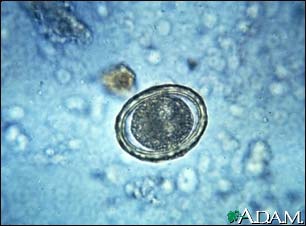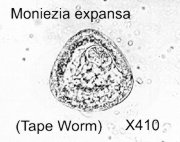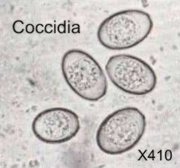Heres what I learned about testing for worms. Let me start by saying that Im not an expert on veterinary parasitology. Ive been quite interested in parasites in backyard flocks and decided to take this opportunity to learn and share what Ive discovered. Ive spent a few days delving into the primary literature as well as web sites discussing worming issues. My aim is to present some of the highlights of what scientists and veterinarians are currently thinking about with quantifying and treating worms. The methods of identifying and counting worm eggs are generally the same, regardless of the animal sampled. The worm species one will need to identify will vary depending on the host species examined.
The McMaster technique
The most widely used test for quantifying worms in fecal samples is the McMaster egg counting technique. The advantage of this test is that you get a relatively reliable count of the number of worm eggs per sample. It also requires very little equipment, just a standard compound microscope, things to measure and strain the feces, floatation solution and a McMaster slide. Ive read that you can purchase the equipment for under $200 and as little as $100 if you look around and buy used. The McMaster slide has two grids etched onto it with the grid covering a particular volume. You simply measure out a volume of feces and put it into the floatation solution (which can be made from common things found in the home), strain the feces and place a sample onto the slide and wait five minutes for the eggs to float to the top. You then count the eggs contained within the grids. By knowing the volume of feces and floatation solution and the counts of the volume on the slide, you can easily calculate eggs per gram (EPG). This test is good for quantifying the number of eggs in most livestock feces; different species might require different fecal preparation procedures.
Here is an excellent site with a complete tutorial on how to conduct the various egg counting techniques, including the McMasters and images of the egg types for poultry, ruminants and pigs: http://www.rvc.ac.uk/review/Parasitology/EggCount/Principle.htm. This site provides very specific instructions, an equipment list and also explains how to calculate EPG.
Here is a site that sells home kits for poultry diseases (worms, coccidiosis): http://www.brunelmicroscopes.co.uk/coccidiosis.html and here is another kit, cheaper, but without the microscope: http://www.vetslides.com/EPGfecalkit.html
I think that just about anyone could learn to count the worm eggs in their own animals; its very much like following a recipe. Exact, repeatable measurements are a must. The main limitation would be in your ability to differentiate and identify the worm eggs. If you look at online pictures of different egg species and dont see obvious differences, you might have to work harder on those skills. Because youre working with fecal material and potential pathogens, safety measures should be thoroughly researched and employed.
Interestingly, when a group of organisms is tested, usually one or two individuals are shown to be shedding the greatest numbers of parasitic eggs. Most of the group will be shedding a relatively lower baseline number and are thought to be more parasite resistant. Once you know which individual animals in your group are shedding the most worm eggs and the species of worm, you can choose an appropriate de-wormer (anthelmintic) and target those individuals, rather than treat the entire group. The idea is to strategically limit exposure of the worms to de-wormer so that you do not breed resistant worms.
At what EPG count would you decide to worm?
This is a hotly debated issue and can vary by host and worm species as well as the agency or group making the recommendation. As if it werent complicated enough, certain worms are more active during particular times of year, and therefore, baseline counts can vary with season. I found various values for sheep, goats and horses, but nothing for poultry. They actually might be available; I simply have not found them yet. Im waiting on several papers I yet need to read. I expect the recommendations to be included in the WAAVP guidelines (described below).
Fecal Egg Count Reduction Test (FECRT)
The FECRT is simply a way to determine if your de-wormer is effective. You first conduct a quantitative test, such as the McMasters, and THEN de-worm your animals. After a period of time, typically 10-15 days, the animals are re-tested. One can then calculate the percentage that the eggs were reduced by the de-worming treatment. Its a generally accepted standard (albeit seemingly arbitrary) that a 95% reduction or less in eggs following treatment indicates that worms are resistant to the de-wormer (e.g.: http://sheep.osu.edu/2008/06/20/determining-worm-resistance-to-dewormers/). Again, the 95% value is somewhat controversial; some argue that anything less than 99% indicates resistance to the dewormer (e.g.: http://www.cluthavets.co.nz/sheep-preparation-for-faecal-egg-count-reduction-testing-fecrt.html). Whatever cut-off value you choose, the FECRT data will tell you if your wormer is effective or if you need to use a different product. Here are the references to the guidelines of the World Association for the Advancement of Veterinary Parasitology (WAAVP) on how to evaluate the effectiveness of a de-wormer for various livestock species: http://www.waavp.org/node/25.
It turns out that lots of people do home testing for worms, especially those with goats and sheep, but also those with cattle, horses and swine. I was surprised at the number of web sites individuals have created describing their own methods for quantifying worms. This is, in large part, out of necessity. Unfortunately, worms become resistant to specific de-wormers and once a resistant strain spreads, the consequences can be costly. Perhaps the most fascinating thing I discovered is that many breeders are using FECRT counts to identify individuals with consistently high or low values and then using that knowledge to inform culling and breeding decisions. In that way, they are able to increase resistance to worms in their bloodlines. This may be the single best reason to quantify and monitor worms in backyard poultry flocks.
Here is an excellent synopsis of the issues and description of methods: http://www.scsrpc.org/SCSRPC/Publications/part6.htm This document was produced by the most awesomely named, Southern Consortium for Small Ruminant Parasite Control. The article deals specifically with goats, but the issues for worm assessment and control are well explained.
Here is a recent review of the scientific research on worming issues in horses: http://www.ncbi.nlm.nih.gov/pmc/articles/PMC2751843/ Again, while it deals with horses and not poultry, it describes what can happen when de-worming practices lag behind current veterinary recommendations.
If you are thinking about assessing worms in your own backyard flock, arm yourself with the best current knowledge and do your own research. Here are some good terms to use in your online searches: anthelmintic, FECRT, anthelmintic resistance, worm resistance.
As I learn more, I'll update what I'm learning here and on the byc page I'm making on parasitic worms: https://www.backyardchickens.com/web/viewblog.php?id=56638-parasitic-worms I'm looking forward to hearing what others are doing!
The McMaster technique
The most widely used test for quantifying worms in fecal samples is the McMaster egg counting technique. The advantage of this test is that you get a relatively reliable count of the number of worm eggs per sample. It also requires very little equipment, just a standard compound microscope, things to measure and strain the feces, floatation solution and a McMaster slide. Ive read that you can purchase the equipment for under $200 and as little as $100 if you look around and buy used. The McMaster slide has two grids etched onto it with the grid covering a particular volume. You simply measure out a volume of feces and put it into the floatation solution (which can be made from common things found in the home), strain the feces and place a sample onto the slide and wait five minutes for the eggs to float to the top. You then count the eggs contained within the grids. By knowing the volume of feces and floatation solution and the counts of the volume on the slide, you can easily calculate eggs per gram (EPG). This test is good for quantifying the number of eggs in most livestock feces; different species might require different fecal preparation procedures.
Here is an excellent site with a complete tutorial on how to conduct the various egg counting techniques, including the McMasters and images of the egg types for poultry, ruminants and pigs: http://www.rvc.ac.uk/review/Parasitology/EggCount/Principle.htm. This site provides very specific instructions, an equipment list and also explains how to calculate EPG.
Here is a site that sells home kits for poultry diseases (worms, coccidiosis): http://www.brunelmicroscopes.co.uk/coccidiosis.html and here is another kit, cheaper, but without the microscope: http://www.vetslides.com/EPGfecalkit.html
I think that just about anyone could learn to count the worm eggs in their own animals; its very much like following a recipe. Exact, repeatable measurements are a must. The main limitation would be in your ability to differentiate and identify the worm eggs. If you look at online pictures of different egg species and dont see obvious differences, you might have to work harder on those skills. Because youre working with fecal material and potential pathogens, safety measures should be thoroughly researched and employed.
Interestingly, when a group of organisms is tested, usually one or two individuals are shown to be shedding the greatest numbers of parasitic eggs. Most of the group will be shedding a relatively lower baseline number and are thought to be more parasite resistant. Once you know which individual animals in your group are shedding the most worm eggs and the species of worm, you can choose an appropriate de-wormer (anthelmintic) and target those individuals, rather than treat the entire group. The idea is to strategically limit exposure of the worms to de-wormer so that you do not breed resistant worms.
At what EPG count would you decide to worm?
This is a hotly debated issue and can vary by host and worm species as well as the agency or group making the recommendation. As if it werent complicated enough, certain worms are more active during particular times of year, and therefore, baseline counts can vary with season. I found various values for sheep, goats and horses, but nothing for poultry. They actually might be available; I simply have not found them yet. Im waiting on several papers I yet need to read. I expect the recommendations to be included in the WAAVP guidelines (described below).
Fecal Egg Count Reduction Test (FECRT)
The FECRT is simply a way to determine if your de-wormer is effective. You first conduct a quantitative test, such as the McMasters, and THEN de-worm your animals. After a period of time, typically 10-15 days, the animals are re-tested. One can then calculate the percentage that the eggs were reduced by the de-worming treatment. Its a generally accepted standard (albeit seemingly arbitrary) that a 95% reduction or less in eggs following treatment indicates that worms are resistant to the de-wormer (e.g.: http://sheep.osu.edu/2008/06/20/determining-worm-resistance-to-dewormers/). Again, the 95% value is somewhat controversial; some argue that anything less than 99% indicates resistance to the dewormer (e.g.: http://www.cluthavets.co.nz/sheep-preparation-for-faecal-egg-count-reduction-testing-fecrt.html). Whatever cut-off value you choose, the FECRT data will tell you if your wormer is effective or if you need to use a different product. Here are the references to the guidelines of the World Association for the Advancement of Veterinary Parasitology (WAAVP) on how to evaluate the effectiveness of a de-wormer for various livestock species: http://www.waavp.org/node/25.
It turns out that lots of people do home testing for worms, especially those with goats and sheep, but also those with cattle, horses and swine. I was surprised at the number of web sites individuals have created describing their own methods for quantifying worms. This is, in large part, out of necessity. Unfortunately, worms become resistant to specific de-wormers and once a resistant strain spreads, the consequences can be costly. Perhaps the most fascinating thing I discovered is that many breeders are using FECRT counts to identify individuals with consistently high or low values and then using that knowledge to inform culling and breeding decisions. In that way, they are able to increase resistance to worms in their bloodlines. This may be the single best reason to quantify and monitor worms in backyard poultry flocks.
Here is an excellent synopsis of the issues and description of methods: http://www.scsrpc.org/SCSRPC/Publications/part6.htm This document was produced by the most awesomely named, Southern Consortium for Small Ruminant Parasite Control. The article deals specifically with goats, but the issues for worm assessment and control are well explained.
Here is a recent review of the scientific research on worming issues in horses: http://www.ncbi.nlm.nih.gov/pmc/articles/PMC2751843/ Again, while it deals with horses and not poultry, it describes what can happen when de-worming practices lag behind current veterinary recommendations.
If you are thinking about assessing worms in your own backyard flock, arm yourself with the best current knowledge and do your own research. Here are some good terms to use in your online searches: anthelmintic, FECRT, anthelmintic resistance, worm resistance.
As I learn more, I'll update what I'm learning here and on the byc page I'm making on parasitic worms: https://www.backyardchickens.com/web/viewblog.php?id=56638-parasitic-worms I'm looking forward to hearing what others are doing!
Last edited:












